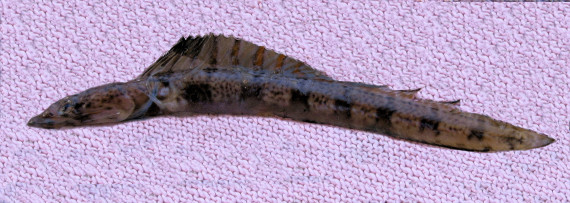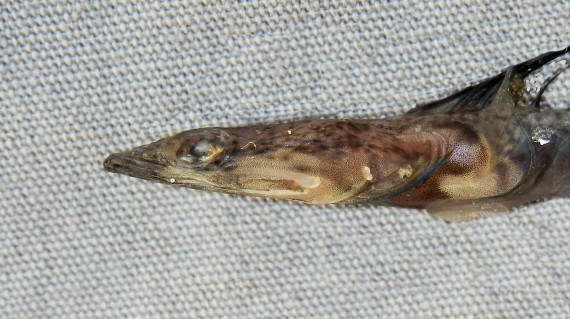Orangethroat Pikeblenny, Chaenopsis alepidota

 Orangethroat Pikeblenny, Chaenopsis alepidota, Female. Provided by the commercial fishermen of the greater Los Cabos area, Baja California Sur, February 2014. Length: 5.3 cm (2.1 inches). Identification courtesy of Dr. Phil Hastings, Scripps Institution of Oceanography, La Jolla, California.
Orangethroat Pikeblenny, Chaenopsis alepidota, Female. Provided by the commercial fishermen of the greater Los Cabos area, Baja California Sur, February 2014. Length: 5.3 cm (2.1 inches). Identification courtesy of Dr. Phil Hastings, Scripps Institution of Oceanography, La Jolla, California.
The Orangethroat Pikeblenny, Chaenopsis alepidota, is a member of the Tube Blenny or Chaenopsidae Family, that is known in Mexico as tubícola lucio. Globally, there are twelve species in the genus Chaenopsis, four of which are found in Mexican waters, two in the Atlantic and two in the Pacific Ocean.
The Orangethroat Pikeblenny has a very elongated body. They are pale green overall with longitudinal rows of white spots along their mid-flank and at the base of their dorsal fin. They also have 8 to 10 green to dark brown bars on their sides. They are dimorphic with males being larger and more colorful than females having a black dorsal fin, a blue-gray belly, blue-gray spotting on their body, a black chin and throat, and an orange stripe from the rear of their mouth across the gill covers. Females have a dark spot on the front of their dorsal fin. Their head has a long and strongly pointed snout, a long mouth that reaches past the eyes, and a projecting lower jaw. They have a few teeth on the roof of their mouth. Their anal fin has 2 spines and 34 to 37 rays; their caudal fin is rounded and continuous with the anal and dorsal fins; and, their dorsal fin has an elevated first half with 18 to 20 spines and 34 to 36 rays.
The Orangethroat Pikeblenny is a coastal shallow water predatory species found in the tubes of certain worms within sand rubble bottoms along the margins of coral reefs at depths up to 23 n (75 feet). They are common and often conspicuous close to shelter holes that are primarily tubes constructed by polychaete worms. They reach a maximum of 15.2 cm (6.0 inches) in length. They are non-territorial and highly mobile having large home ranges; they will move frequently to locations where shelter is abundant. They are active diurnally feeding on small benthic and epibenthic crustaceans and plankton. Reproduction is oviparous with an initial courtship followed by spawning of demersal eggs that are deposited in shelters where males defend them vigorously until hatching. Population sizes vary widely by location which is attributed to local habitat suitability and reproduction success. The Orangethroat Pikeblenny is poorly studied with very limited information available about their lifestyle and behavioral patterns including specific details on age, growth, longevity, movement patterns, diet, habitat use, and reproduction.
The Orangethroat Pikeblennies is a resident of Mexican waters of the Pacific Ocean but has a limited distribution being found from Todos Santos, Baja California Sur, northward along the west coast of Baja and from Mazatlán, Sinaloa, southward to Guatemala along the coast of the mainland. The fish pictured below illustrates a range extension for this species to the extreme southwest coast of Baja.
Due to its unique markings and body shape, the Orangethroat Pikeblenny cannot be easily confused with any other species with the possible exception of the Cortez Pikeblenny, Chaenopsis coheni (ventral row of bars).
From a conservation perspective the Orangethroat Pikeblennies is currently considered to be of Least Concern with stable, widely distributed populations. They are small in stature and of limited interest to most with the exception of underwater photographers.